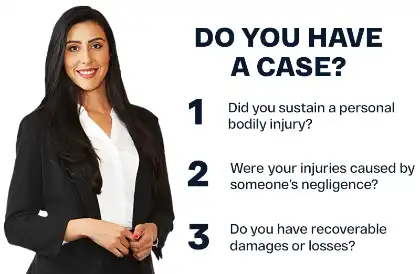California Back Injury Attorneys
- PAY NOTHING UPFRONT
- OVER $0 MILLION RECOVERED
- ZERO-FEES UNTIL WE WIN
We’ll tell you if you have a case or not, call (888) 488-1391 — We’re here 24 hours a day.
California Back Injury Attorneys Delivering Legal Counsel In Challenging Times
Injured your back or spine in an accident? Connect with our California back injury attorneys to discuss your situation and potential legal options. Call us at (888) 488-1391 for a free initial consultation.
The back supports the spinal cord, which is an essential part of the central nervous system. Back injuries can endanger the spinal cord. In severe cases, a back injury can lead to paralysis or even death. Because of the potential severity of back injuries, it is crucial to seek medical attention immediately after an accident.
A back trauma that seems mild could injure your spinal cord if it is not treated appropriately. Even seemingly minor back injuries can cause persistent pain that impacts your daily life for years to come. Getting medical treatment as soon as possible after an accident occurs will give your body the best possible chance of recovering from your injuries.
Once your medical needs have been addressed, you should also consult with a personal injury attorney. You have the right to pursue compensation for injuries caused by another person’s negligence. If a spinal cord injury leads to paralysis or death, the potential compensation available depends on the specific circumstances of the case. You need to protect this legal right to pay your medical bills and provide for your family after an accident occurs.
What Happens If The Spinal Cord Is Injured?
Your back injuries will depend on how badly your spinal cord was injured. Minor injuries might result in pain and discomfort that resolves in a few days. More severe injuries can result in a longer recovery. You might even need pain management and other medical treatment, as back injuries can be incredibly painful.
If the spinal cord is seriously injured, you could have paralysis. Sometimes this is temporary. If the spinal cord is bruised or strained, it might need a few days or weeks to recover. Once it does, a patient might be able to regain sensory and motor functions. But in other cases, paralysis is permanent.
These victims are left permanently unable to feel or use various parts of the body. The areas that are impacted will depend on where the spinal cord injury occurred. The higher the damage, the more body parts will be affected. The following is how medical professionals grade paralysis cases:
- Tetraplegia or Quadriplegia — This is when paralysis occurs from the neck down. The patient loses sensation in both arms and both legs, and the ability to move any of these four extremities.
- Triplegia — Triplegia refers to cases in which three of the patient’s four extremities are paralyzed.
- Paraplegia — Paraplegia is paralysis of the legs and lower body.

How Do Back Injuries Occur?
According to the American Chiropractic Association, back pain is the leading cause of disability throughout the world. This pain prevents people from engaging in work, hobbies, family activities, and other principal aspects of daily life. Because back injuries can seriously impact daily life, injured individuals may be able to seek compensation when another party’s negligence is involved.
Back injuries can be the result of:
- Car Accidents
- Work Accidents
- Sporting Activities
- A Violent Attack
- Surgical Complications
- Nursing Home Abuse
- Slips or Falls
What Types Of Back Injuries Can I Sustain In An Accident?
There are many different ways that your back could be injured in an accident. As we have discussed, the spinal cord itself can be injured, leading to paralysis. This paralysis is the result of damage to the nerves within the spinal cord. However, nerves are not the only structures in the back that can be injured. Injuries to the discs between your spinal vertebrae are quite common.
The vertebrae protect the spinal cord, so they are often injured before the spinal cord is damaged. A broken back can be incredibly painful. It can also lead to complications with the discs, joints, and other soft tissues in the area.
These injuries could be a strain or a herniation, which can be incredibly painful. They can also lead to other conditions over time, such as spinal stenosis, in which a bone fragment or slipped disc puts pressure on the spinal cord. Disc injuries can also aggravate underlying spine conditions.
Some injuries, such as whiplash, involve both the bony vertebrae and the soft tissue of the back. It causes the vertebrae to compress. It can also strain the muscles, tendons, and ligaments in the neck. Whiplash is just one example of such an injury. The back is a complicated bone, nerve, and soft tissue system, and all of these systems must work together for proper function. Even a minor injury can seriously disrupt this complicated network.

What Are Some Common Symptoms Of Back Injuries?
You should seek medical attention any time you suspect a back injury. Like other injuries, these can become worse if they are left untreated. Pain and discomfort are the most common symptoms of a back injury.
Other symptoms are even more concerning. Call your doctor right away if you experience:
- Numbness Or Tingling
- A Weakness Of The Extremities
- Loss Of Coordination
- Muscle Spasms
- Loss Of Control Of Your Bladder Or Bowels
- Fever
- Difficulty Breathing
You should also see a doctor if any of your symptoms persist. If your body is not healing correctly on its own, you likely need medical treatment. A negligent party may be held legally responsible for medical costs if their actions caused a back injury.
What Are The Costs Of Back Injury?
There are many types of losses you will sustain as a result of your back injury. First, there are economic losses. These are the costs that can be documented with receipts and other paperwork, such as:
- Medical bills (for treatment, equipment, and medications)
- Lost wages (including bonuses, commissions, and any lost benefits)
- Property damage
There are also non-economic damages. These are the losses that cannot be valued with a receipt but can still be compensated for in a personal injury lawsuit. These include:
- Pain and suffering
- Loss of enjoyment of life
- Missing out on significant life events (graduations, weddings, etc.)
- Changes in your daily life (not being able to hold your children, giving up hobbies, etc.)
In some particularly serious cases of misconduct, courts might also award punitive damages along with other compensation to emphasize accountability. As the name implies, punitive damages are designed only to punish the defendant. They deter the defendant (and other potential defendants) from engaging in egregious, dangerous conduct in the future.
The law also allows injury victims to pursue compensation for the future losses they will suffer due to the defendant’s negligence. For example, severe back injuries can leave a victim permanently unable to work. Courts may award damages for lost wages through retirement if a severe back injury permanently limits a person’s ability to work.
This compensation includes all benefits, too. Health insurance, employer contributions to retirement plans, and other losses can be compensated if they would have been earned by working. Similarly, a victim can collect compensation for the estimated medical expenses incurred due to the accident for the rest of their life.
In cases of severe back and paralysis injuries, these costs can be staggering. A paralyzed injury victim might require full-time home care for the rest of their life. Added to the cost of additional surgeries and hospitalizations, consultations with medical specialists, and routine visits with a host of doctors, the cost of future care for a serious injury can be significant. These costs may represent a large portion of a compensation claim, depending on your specific circumstances.
What Is The Deadline For Filing My Back Injury Claim?
Most personal injury claims have a statute of limitations of two years from the date of injury. Because of the statute of limitations, you can only file a lawsuit within two years of the accident. If that time has passed and you have not filed a suit, the defendant can have the case dismissed without paying you anything. It is important to start negotiations before then, so you have plenty of time to file a lawsuit if necessary.
In some cases, there will be other deadlines that you must meet before the statute of limitations. If you are filing a suit against a government agency, you must provide them with notice of your claim within six months of the accident.
Failure to do so can result in your case being dismissed – even if you file the lawsuit within the required time. It is essential to consult with a personal injury lawyer about your case as soon as possible. First, the attorney will be able to identify any applicable deadlines. Second, your attorney will start preserving any evidence that might be necessary for your claim.
This evidence includes surveillance footage, police reports, photos, witness statements, and other documentation. If your attorney does not work to preserve this information, it might not be available when you need it to support your case. For example, store security surveillance footage is usually erased after a certain amount of time has passed. If you do not request a copy right away, it might be gone before you can show it in court.
Sometimes, a company or individual will be resistant to providing information. In this case, your attorney might need to subpoena them to obtain the evidence. A subpoena is a court order that requires the production of documents or evidence.
A subpoena can also be used to require a witness to appear in court to testify. Your attorney cannot issue a subpoena until a lawsuit has been filed. Your attorney may need to file a lawsuit quickly to issue a subpoena and preserve important evidence, which is why it is critical to consult with them as soon as you can following an accident.
Experienced Back Injury Attorneys For California Injury Victims
If you or a loved one has sustained a back injury in an accident, it is essential to consult with a personal injury attorney as soon as possible. You have the legal right to pursue compensation for damages caused by another person. The sooner an attorney is involved, the better protected your legal rights can be.
After sustaining a back injury, one may want to look for the best personal injury lawyer for help. While no attorney may claim to be the best, our team can guide clients through settlement negotiations and, when necessary, pursue their case in court. Call Arash Law at (888) 488-1391 to schedule your free initial consultation with one of our experienced California injury attorneys under Arash Khorsandi.
Our team includes experienced personal injury lawyers and car accident lawyers who handle back injury cases. We represent clients in San Francisco, Riverside, San Jose, San Diego, Sacramento, Sherman Oaks, and across California.





















